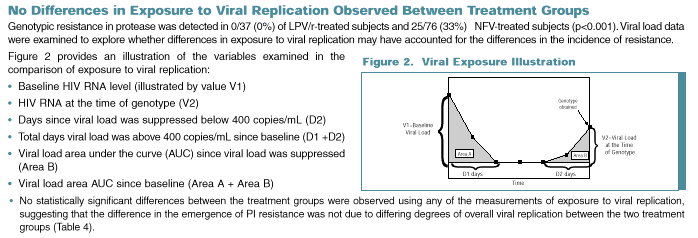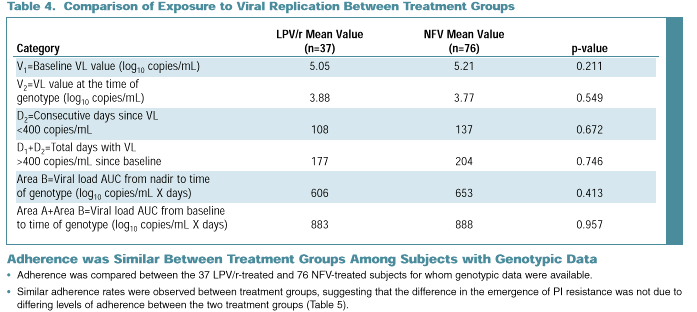
 |
Share this Poster with a Colleague
Abstract:
The relative incidence of resistance to PI-based HAART in treatment-naïve subjects has not been examined in comparative clinical studies. Study M98-863 is a randomized, double-blind Phase III study of 653 ARV-naïve subjects treated with either lopinavir/r (LPV/r) or nelfinavir (NFV), in combination with d4T/3TC. To quantify the emergence of resistance to these regimens, viral isolates from all subjects with viral load >400 copies/mL on treatment at Weeks 24, 32, 40 and 48 were analyzed. A greater number of subjects in the NFV arm had viral loads >400 copies at each time point. Isolates from 37 of 58 LPV/r and 76 of 102 NFV-treated subjects were amplifiable for sequencing of the protease and reverse transcriptase (RT) genes. No evidence (0/37) of genotypic resistance to LPV, defined broadly as the appearance of any primary or active site mutation in protease, was observed in any isolates from LPV/r-treated subjects through Week 48. Absence of resistance to LPV was confirmed by phenotypic analysis in 36/37 LPV/r-treated subjects. In contrast, rebound isolates from 25/76 (33%) of NFV-treated subjects displayed evidence of genotypic resistance to NFV, defined as the appearance of the D30N and/or L90M mutations (p<0.001 for the comparison between treatment arms). The incidence of genotypic resistance to 3TC (appearance of the M184I/V mutation in RT) in the LPV/r arm (15/37, 41%) was statistically significantly lower (p<0.001) than in the NFV arm (62/76, 82%).There were no significant differences in the duration or level of detectable viremia between treatment arms in the subjects with available genotype. These results suggest that the genetic barrier to resistance to LPV in treatment-naïve subjects is higher than the barrier to NFV resistance.
Background:
LPV is a novel HIV protease inhibitor (PI) that has shown significant antiviral activity and tolerability in clinical trials to date. LPV is co-formulated with ritonavir (RTV), an inhibitor of cytochrome P450 3A. It is highly sensitive to pharmacokinetic enhancement by RTV, resulting in substantially increased LPV drug exposure, even at low RTV doses. The efficacy and safety of LPV/r are currently being studied in both ARV-naïve and PI-experienced HIV-infected subjects. Study M98-863 is a large, blinded, randomized, prospective study comparing the activity and safety of LPV/r plus d4T and 3TC to that of NFV plus d4T and 3TC in ARV-naïve subjects. A total of 653 subjects enrolled in the study. The mean baseline HIV RNA level was 4.9 log 10 copies/mL, and the mean baseline CD4 cell count was 259 cells/mm 3 . At Week 48, a statistically significantly greater proportion of subjects in LPV/r-treated group had viral load (VL) below 400 copies/mL (75% vs. 63%, p<0.001) or below 50 copies/mL (67% vs. 52%, p<0.001) using an intent-to-treat (ITT) (missing=failure) analysis 1 (Figure 1a and 1b).


Through Week 48, LPV/r-treated subjects and NFV-treated subjects demonstrated similar adherence to study medications.1
Objective:
To characterize the incidence of resistance through 48 weeks in a randomized double-blind, Phase III study comparing the efficacy and safety of LPV/r plus d4T and 3TC to that of NFV plus d4T and 3TC in ARV-naïve subjects.
Methods:
Genotypic/Phenotypic Resistance
Samples were analyzed from all subjects with viral load >400 copies/mL at Weeks 24, 32, 40 or 48. Genotype (GeneSeq ™ ) and phenotype (PhenoSense ™ ) were performed by ViroLogic, Inc. Genotypic resistance to NFV was defined as the presence of a D30N and/or L90M mutation in protease. Genotypic resistance to LPV was defined as the presence of any primary or active site mutation in protease (amino acids 8, 30, 32, 46, 47, 48, 50, 82, 84 and 90).2 Phenotypic analyses were performed on all samples obtained from LPV/r-treated subjects to confirm the lack of genotypic resistance to LPV. Resistance to 3TC was defined as the presence of an M184V or M184I mutation in reverse transcriptase.
Adherence
Adherence was measured by pill counts of protease inhibitor (non-placebo). The adherence between each study visit and overall was computed as the percentage of pills consumed relative to the expected number consumed. The "minimum adherence rate" was defined as the lowest of the adherence rates between visits.
Analysis of Exposure to Viral Replication
A total of 58 LPV/r-treated and 102 NFV-treated subjects had a viral load >400 copies/mL at Weeks 24, 32, 40, or 48. For subjects with multiple viral loads >400 copies/mL during Weeks 24-48, the latest sample was used for genotypic analysis, unless resistance had been previously identified at Week 24. Samples selected for analysis are summarized in Table 1.

Statistics
P-values for categorical variables were based on Fisher’s exact test. Quantitative variables were analyzed using a one-way analysis of variance.
Results:
Lower Incidence of Resistance in LPV/r-Treated Subjects

| Table 3. Analysis of the Appearance of Secondary Mutations in Conjunctions with D30N or L90M | ||
|
Subjects with D30N and/or L90M Mutations (n=25) |
||
| No. Subjects with: | No. of Subjects with: | |
| 1 secondary mutation 8 | L10F, I or V mutation(s) 2 | A71V mutation 6 |
| 2 secondary mutations 2 | M36I, or V mutation(s) 5 | G73S mutation 1 |
| 3 secondary mutations 2 | M46I, or V mutation(s) 3 | N88D mutation 1 |





Conclusions:
References:
© 2000 Medical Advocates
for Social Justice
225 West Washington Street, Suite 2200, Chicago, IL 60606
Telephone (312) 419-7289 Facsimile: (312) 419-7151
Email: info@medadvocates.org